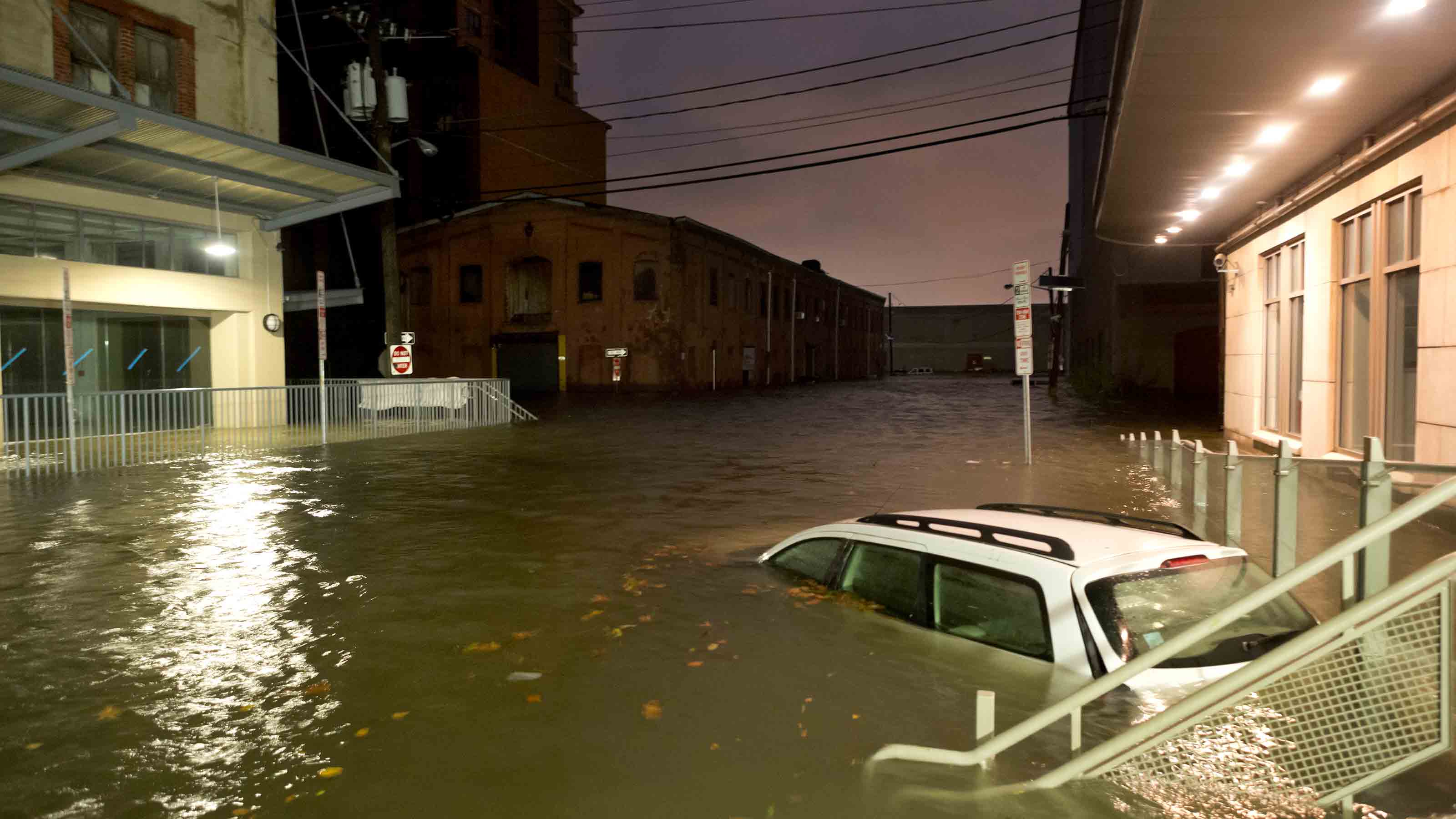Watch Out for Flood-Damaged Cars from Hurricane Ian
Even if Hurricane Ian passed you by unharmed, pay attention if you’re in the market for a vehicle. And be prepared to pay even more.


Among the destruction caused by Hurricane Ian, both across Florida and in areas of the East Coast that suffered its wrath: flooded vehicles. While this is a common outcome of cyclonic storms and their heavy rain and storm surge, Hurricane Ian struck in the middle of an already stressed car market.
You’ve probably heard about how an ongoing semiconductor shortage has led to a shortage of new cars; that in turn has raised demand (and prices on) used cars.
Just how many vehicles Hurricane Ian damaged will be assessed in the weeks to come, but if past is prologue, take a look at what Category 4 Atlantic Hurricane Ida did in 2021: It caused water damage to 212,000 cars, according to an estimate from CarFax.
Consumers having to replace hundreds of thousands of cars is about the last thing this market needed. But also: what happens to the flooded vehicles? Because water, whether salt or fresh, is so damaging to vehicles, many are written off as total losses, which means their owner (assuming they have comprehensive coverage on the vehicle) gets a check and is on their own to find a new car. But a portion of those flood damaged vehicles will be repaired and put back into service. That’s where car shoppers need to pay attention.
“CarFax estimates there are currently about 400,000 vehicles on the road with prior flood damage,” said Emilie Voss, public relations director for CarFax. “That’s up 6% from 2021 and those numbers are before Ian.”
Experts warn consumers shopping for used cars to be wary of the possibility of storm-damaged vehicles making their way into this tight market in 2023.

Sign up for Kiplinger’s Free E-Newsletters
Profit and prosper with the best of expert advice on investing, taxes, retirement, personal finance and more - straight to your e-mail.
Profit and prosper with the best of expert advice - straight to your e-mail.
Hiding Flood Damage Is Against the Law
When cars are flooded, bodies can rust prematurely, wiring can become brittle, and both electrical and mechanical systems can be affected – pricey computer modules mounted under the seats are a frequent victim.
Cars that are declared to be total losses are usually retitled with their state’s department of motor vehicles, and the new titles will disclose that the vehicles have been flood-damaged. In many cases, those cars will be sold to companies that dismantle them and resell usable parts. But sometimes people try to sell these cars without revealing the flood damage, which could create big risks for the buyers.
CarFax and the National Insurance Crime Bureau warn potential buyers to expect people with storm-damaged cars who don’t have comprehensive coverage insurance that covers flooding to try to clean up damaged cars and sell them to unsuspecting buyers.
“Many times, con men move these vehicles damaged in hurricanes from states like Florida and Texas, to states where flood damaged vehicles may not be top of mind, like Ohio and Connecticut,” said CarFax’s Voss. “Texas and Florida have the most flood cars on the road but we saw the biggest increases in New York and New Jersey last year, likely tied to Ida.
How to Avoid Buying a Flood-Damaged Car
If you’re buying a used car—especially one a few months after a major flooding event—be sure to take a close look. Your own eyes (and nose!) can help. Signs experts say you should look for include water stains, mildew and sand or salt inside vehicles, under the carpets and in luggage and engine compartments. You may need to open access panels to see areas where water would have accumulated. Of course, a mechanic’s inspection is always a good idea when buying a car, and if you suspect unreported flood damage, ask them to look for that as well as part of their process.
But documentation is important, too. Experts also advise using a service, such as CarFax, AutoCheck’s free VIN (or license plate) search tool and the National Insurance Crime Bureau’s free VINCheck to check vehicles’ histories for red flags. CarFax’s free Flood Check reports whether a car has a flood or salvage title from the state DMV, was declared a total loss by the insurance company, or was reported as flooded by repair shops. And Experian’s AutoCheck’s free flood risk check will show if the vehicle has been titled/registered 12 months prior in a county that has been identified as requiring public and individual assistance (FEMA categories A and B) for a FEMA-declared major disaster.
These services aren’t foolproof. Flooded vehicles won’t show up in the databases if they weren’t fully insured, or if repairs were done without a claim being filed. Also, sometimes crooks take the autos to different states, switch the VINs and retitle the cars, so the damage won’t show up in a search, in a process called title washing.
Most of the time it’s against the law to pass off a flood-damaged vehicle to an unsuspecting buyer. “Regulations vary by state, but in general vehicles ’totaled out’ by insurers because they have received a certain amount of damage are issued a salvage vehicle certificate, or salvage title,” said Tully Lehman, public affairs manager for the National Insurance Crime Bureau. “Some states take an additional step and add a title brand to the title for the reason why it was damaged. In other words, if damaged in flooding that would be marked as such in some states.”
But private sales aren’t as regulated, according to Lehman. “A private seller is not supposed to lie. If purchasing a vehicle from a private seller, get everything in writing as you may have some recourse should anything turn out to be false,” said Lehman.
When purchasing a used car, you should always check the VIN to be sure it matches what you’re being told by the seller.
For example, a VIN can provide vehicle history, but also make, model, year, color and engine. So alarm bells should sound if you’re told the car you’re buying is a blue 2006 Honda Accord, but when you look up the VIN it says it’s a 2004 or that its color is black.
“It could be an honest mistake by the seller, or perhaps not,” Lehman said. “In this case, best to walk away.”
Get Kiplinger Today newsletter — free
Profit and prosper with the best of Kiplinger's advice on investing, taxes, retirement, personal finance and much more. Delivered daily. Enter your email in the box and click Sign Me Up.

Bob was Senior Editor at Kiplinger.com for seven years and is now a contributor to the website. He has more than 40 years of experience in online, print and visual journalism. Bob has worked as an award-winning writer and editor in the Washington, D.C., market as well as at news organizations in New York, Michigan and California. Bob joined Kiplinger in 2016, bringing a wealth of expertise covering retail, entertainment, and money-saving trends and topics. He was one of the first journalists at a daily news organization to aggressively cover retail as a specialty and has been lauded in the retail industry for his expertise. Bob has also been an adjunct and associate professor of print, online and visual journalism at Syracuse University and Ithaca College. He has a master’s degree from Syracuse University’s S.I. Newhouse School of Public Communications and a bachelor’s degree in communications and theater from Hope College.
-
 Designing Your 'Immortal' Financial Plan
Designing Your 'Immortal' Financial PlanExplore an approach that offers solutions for those navigating the intersection of longevity, fulfillment and financial security.
By Dennis McNamara
-
 How to Protect Your Privacy While Using AI
How to Protect Your Privacy While Using AIHow to keep your information and finances safe while using AI, including ChatGPT and Perplexity.
By Bob Haegele
-
 How to Guard Against Identity Theft in 2025
How to Guard Against Identity Theft in 2025Scammers are getting better at impersonating legitimate businesses.
By Mallika Mitra
-
 Roth IRA Contribution Limits for 2025
Roth IRA Contribution Limits for 2025Roth IRAs Roth IRA contribution limits have gone up. Here's what you need to know.
By Jackie Stewart
-
 Four Tips for Renting Out Your Home on Airbnb
Four Tips for Renting Out Your Home on Airbnbreal estate Here's what you should know before listing your home on Airbnb.
By Miriam Cross
-
 Five Ways to a Cheap Last-Minute Vacation
Five Ways to a Cheap Last-Minute VacationTravel It is possible to pull off a cheap last-minute vacation. Here are some tips to make it happen.
By Vaishali Varu
-
 Social Media Scams Cost Consumers $2.7B, Study Shows
Social Media Scams Cost Consumers $2.7B, Study ShowsScams related to online shopping, investment schemes and romance top the FTC's social media list this year.
By Joey Solitro
-
 How to Figure Out How Much Life Insurance You Need
How to Figure Out How Much Life Insurance You Needinsurance Instead of relying on rules of thumb, you’re better off taking a systematic approach to figuring your life insurance needs.
By Kimberly Lankford
-
 Amazon Big Deal Days Is Coming! We’ve Got All the Details
Amazon Big Deal Days Is Coming! We’ve Got All the DetailsAmazon Prime To kick off the holiday season with a bang, Amazon Big Deal Days runs Tuesday, October 8 and Wednesday, October 9.
By Bob Niedt
-
 How to Shop for Life Insurance in 3 Easy Steps
How to Shop for Life Insurance in 3 Easy Stepsinsurance Shopping for life insurance? You may be able to estimate how much you need online, but that's just the start of your search.
By Kaitlin Pitsker